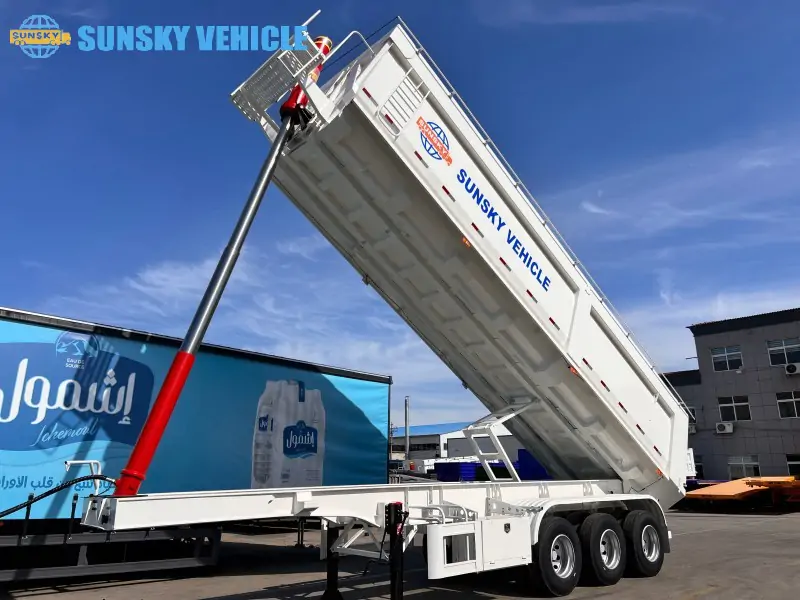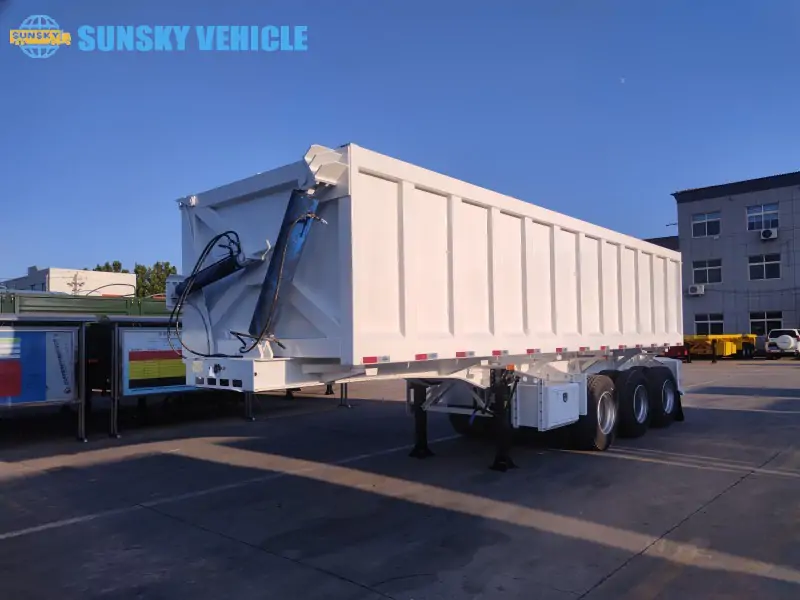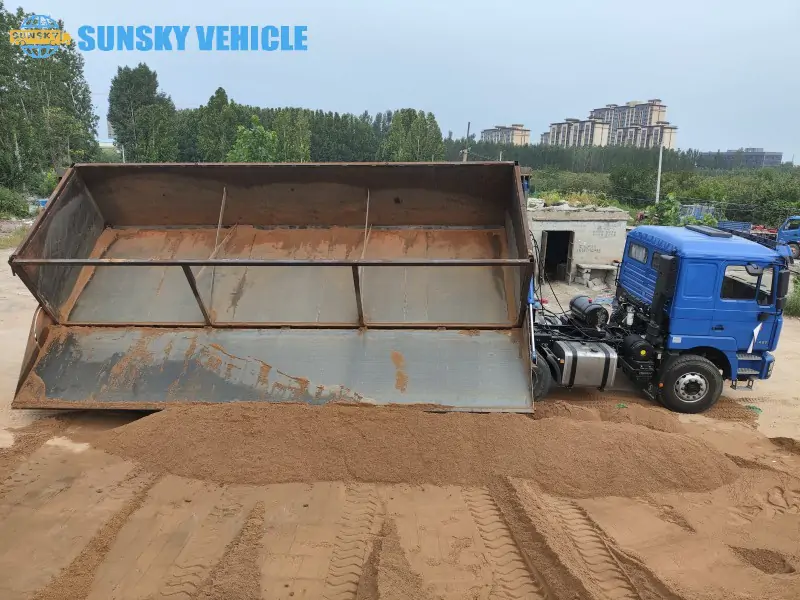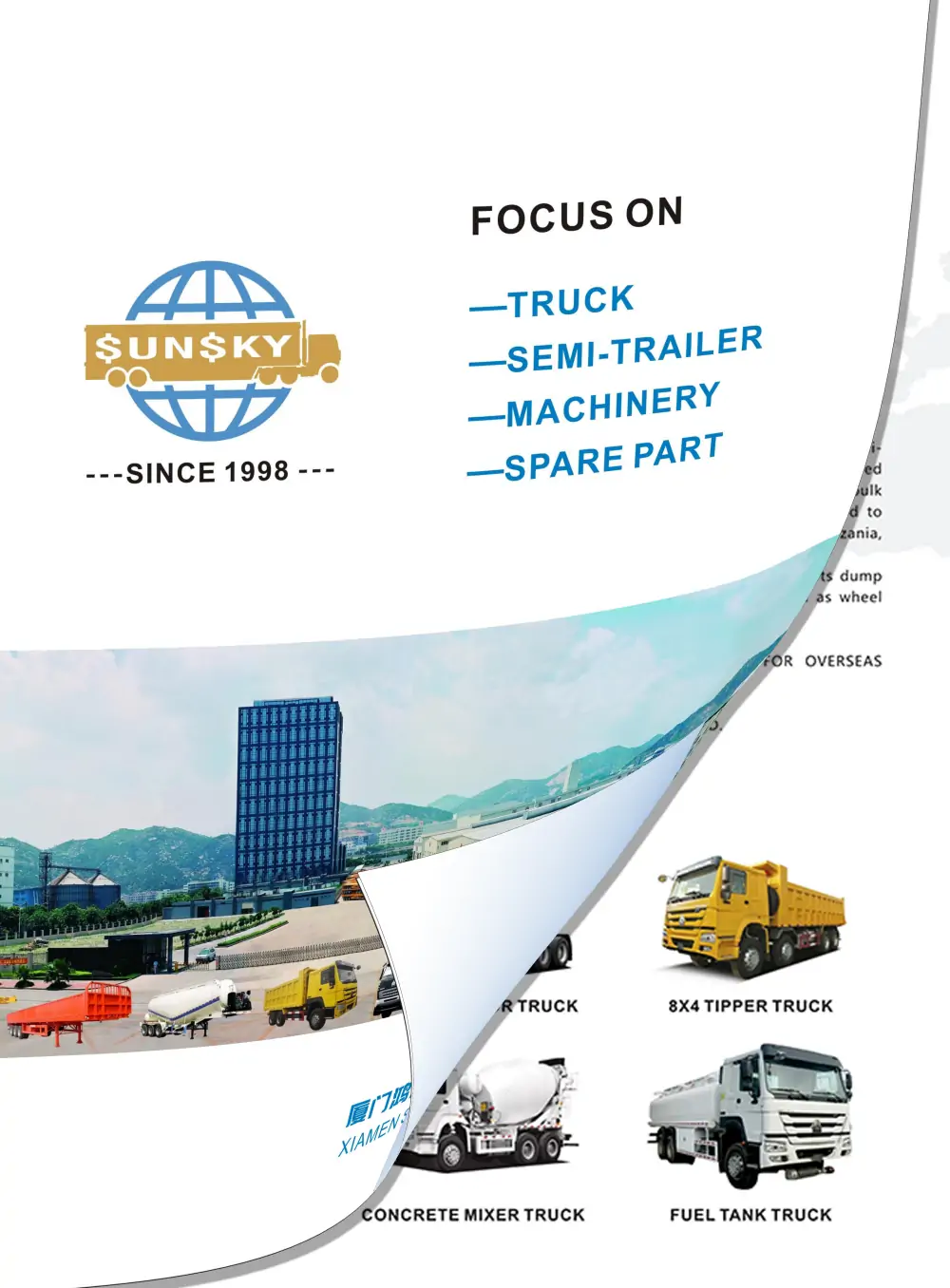The Critical Choice: Stability Meets Hauling Capacity
In the demanding world of heavy construction and material logistics, efficiency equates to profit, and safety is the absolute priority. Yet, selecting the wrong dump trailer can jeopardize both operational efficiency and job site safety. When transporting bulk materials like aggregates, dirt, or demolition debris, the choice between the two dominant mechanisms—the Side Tipper (Lateral Discharge) and the End Tipper (Rear Discharge)—is a critical factor that can make or break your project.
This guide is specifically designed to clearly delineate the core operational and design differences between the End Tipper and the Side Tipper. We promise to deliver a comprehensive analysis of performance, safety, long-term maintenance, and ideal application scenarios to empower fleet managers and procurement specialists to make the most informed investment decision.
Continue reading to master the key elements of optimal dump trailer selection, understanding how each mechanism impacts your Return on Investment (ROI). Furthermore, this article will delve into the critical mechanical differences within the End Tipper category: Front-End vs. Underbody lift systems, helping you fine-tune your choice for maximum stability and long-term durability.
Core Mechanism Breakdown: Side Dump vs. End Dump
The most fundamental difference between these two trailer types lies in how they discharge their cargo. This single distinction dictates their stability profile, hauling capacity, and overall suitability for diverse heavy construction environments.
The High-Capacity Standard: End Tipper Trailer
The End Tipper, often recognized as the standard Rear Discharge Trailer, is a mainstay across construction and mining operations due to its straightforward design and high capacity.
- Working Principle: A powerful hydraulic system lifts the front end of the trailer box, causing the material to slide toward and out of the tailgate. The body elevates to a steep angle (typically 45-50 degrees) to ensure a complete and rapid discharge.
- Pros:
- Higher Effective Payload: End tippers generally feature taller side walls, allowing them to carry significantly greater cubic yardage of material per haul, maximizing efficiency on high-volume routes.
- Material Versatility: Their design, often featuring heavy-sided construction, allows them to handle a wider variety of tough materials, including large demolition debris and heavy aggregate.
- Simple Unloading Area: They only require space behind the trailer, making them effective in constrained loading dock or quarry environments, provided the ground is level.
- Cons:
- Significant Stability Challenge: Because the load is lifted high into the air, the center of gravity is temporarily raised, making the unit highly susceptible to tip-over accidents, particularly on sloped, soft, or uneven ground.
- Unloading Limitations: Requires a flat and expansive area directly behind the trailer for safe operation and material deposit.
The Safety and Versatility Champion: Side Tipper Trailer
The Side Tipper utilizes a lateral discharge system, offering a distinct advantage where safety and difficult terrains are concerned.
- Working Principle: Robust hydraulic rams tilt the entire trailer bed laterally (to the side). The material is then discharged along the length of the trailer, often in a long pile, or “windrow.”
- Pros:
- Superior Stability: Side tippers maintain an extremely low center of gravity during the entire discharge cycle. This allows them to operate safely on uneven, sloped, or soft ground where an End Tipper would be at high risk of rolling over.
- Watertight Capability: Many side tipper designs feature a watertight tub, making them suitable for hauling semi-liquids, sludge, or very fine materials that might leak out of a standard End Tipper’s tailgate.
- Faster Cycle Times: The side tipping motion can be rapid, and some side dumps can even unload while moving slowly, facilitating quick turnaround times.
- Cons:
- Capacity Constraint: Due to their design and the physics of side-tipping, standard side tippers often have a slightly lower cubic yard capacity than their End Tipper counterparts.
- Site-Specific Requirements: They require sufficient lateral clearance to tip, meaning some job sites (like enclosed hoppers or specific pits) may not be configured for their use.
Deep Dive into the End Tipper: Front-End vs. Underbody Mechanics
While the rear-discharge method defines the End Tipper, the choice of its internal hydraulic mechanism—Front-End or Underbody—is paramount for the trailer’s long-term durability, operating cost, and subtle stability characteristics. For procurement experts, understanding this difference translates directly into long-term Return on Investment (ROI).
The Engineering Advantage: Front-End Tipping Mechanism
The Front-End system places the hydraulic cylinder directly between the cab-side bulkheads of the trailer and the chassis.
- Mechanical Efficiency: This configuration provides a superior mechanical advantage, often approximating a 2:1 ratio (where Effort $E = L/2$). This means the system requires half the force to lift the same load compared to an Underbody system, resulting in less stress on the hydraulic components and lower fuel consumption during the dump cycle.
- Durability and Protection: The cylinders are strategically positioned and well-protected within the trailer frame and body. This shielding minimizes exposure to road grime, dust, debris, and potential impact damage, significantly reducing cylinder wear and contamination risks.
- Stability and Structure: The direct, centralized force application minimizes deflection and bending in the chassis, leading to lower fatigue failure risk and overall better structural integrity over the trailer’s lifespan.
The Limitations: Underbody Tipping Mechanism
The Underbody system mounts one or more hydraulic cylinders beneath the trailer box, applying force through a complex system of hinges and supports.
- Mechanical Efficiency: Due to the geometry, the Underbody system offers low or no mechanical advantage (Effort $E \approx L$). This lack of leverage means the hydraulic pump and cylinders must work much harder, leading to higher internal pressure and potential wear on components.
- Maintenance and Exposure Challenge: The cylinders are highly exposed beneath the truck body, making them a vulnerable target. They are prone to damage from dirt, mud, and road debris, which can lead to premature seal failure and costly maintenance.
- Structural Risk: The applied lifting force often concentrates stress in specific areas of the chassis, increasing the potential for bending, deflection, and fatigue failure in the vulnerable undercarriage zone over time.
| Feature | Front-End Tipper Mechanism | Underbody Tipper Mechanism |
| Mechanical Advantage | High ($E = L/2$) | Low/None ($E \approx L$) |
| Cylinder Protection | Excellent (Shielded within body) | Poor (Exposed to road debris) |
| Fatigue Risk | Low (Minimal chassis bending) | High (Prone to deflection/bending) |
| Long-Term ROI | Higher (Lower maintenance/stress) | Lower (Higher component replacement cost) |
Construction Application Analysis and Optimal Selection
Choosing the right tipper trailer is not about finding a universally “better” mechanism, but rather matching the trailer’s strengths to the specific demands and constraints of your construction site or haul route. Here is a breakdown of which tipper mechanism excels in key operational scenarios:
High-Volume, Long-Distance Hauling
- Recommendation: End Tipper Trailer (Rear Discharge).
- Rationale: The End Tipper is the undisputed king of capacity. Its design allows for deeper boxes and higher side walls, translating to significantly greater payload per trip. This makes it the most economical choice for long-distance routes moving high volumes of uniform, dense material like mass aggregates, ore, or common quarried material. The reduced number of trips required directly lowers fuel costs and driver hours, maximizing overall fleet efficiency.
Uneven Ground, Roadsides, or Confined Site Unloading
- Recommendation: Side Tipper Trailer (Lateral Discharge).
- Rationale: Safety is the paramount concern when operating on anything other than perfectly flat, solid ground. The Side Tipper’s superior stability profile (low center of gravity during the dump cycle) allows it to operate where an End Tipper cannot safely venture. Furthermore, for road construction and maintenance, the ability to “windrow” material (dumping in a line) along the roadside without needing to stop and raise the body makes it highly efficient in linear projects where space is restricted or maneuverability is limited.
Fine, Semi-Liquid, or Contaminating Materials Transport
- Recommendation: Side Tipper Trailer (Lateral Discharge).
- Rationale: While End Tippers are versatile, their traditional hinged tailgate is rarely truly watertight. For materials like saturated dirt, waste sludge, or fine silt, leakage is a serious concern, leading to material loss and environmental contamination. The Side Tipper’s design often incorporates a fully sealed, watertight tub, making it the superior choice for containing and safely transporting semi-liquid or extremely fine materials without spillage.
Return on Investment (ROI) and Long-Term Cost Considerations
For fleet owners and construction company CFOs, the choice between tipper mechanisms ultimately boils down to the long-term cost of ownership versus the gains in operational efficiency and safety. Analyzing the financial impact reveals a nuanced picture that goes beyond the initial price tag.
Initial Capital Cost: Upfront Investment
- Side Tipper: These trailers generally command a higher initial investment due to their more complex hydraulic systems, reinforced tubs, and specialized tilting frame mechanisms required to ensure lateral stability.
- End Tipper: The simpler, traditional rear-discharge design means End Tippers typically have a lower upfront purchase price, making them attractive to operations prioritizing immediate capital savings.
Operational Costs: Efficiency vs. Risk
- Side Tipper Efficiency: While more expensive initially, Side Tippers offer faster cycle times and the ability to unload on the fly in certain road applications. This translates directly to time savings and higher utilization rates, lowering the effective cost per ton hauled.
- End Tipper Risk Expense: The primary financial risk with End Tippers is catastrophic failure. If an End Tipper tips over due to operator error or uneven ground, the resulting repair costs, potential cargo loss, insurance claims, and—most significantly—prolonged downtime and project delays can be exponentially higher than the initial trailer cost.
Robust and Durable, Achieve Exceptional Transport Start your project today and get a high-performance semi-trailer solution tailored specifically to your unique needs.
Maintenance and Durability: The Hidden Cost of Design
The mechanical selection within the End Tipper category becomes critical when assessing maintenance:
- Front-End Advantage: Integrating the conclusion from Section 4, the Front-End mechanism End Tipper offers the lowest long-term maintenance costs. Its protected cylinder placement and superior mechanical leverage (requiring less strain) drastically reduce the frequency of hydraulic system failures and component replacements compared to exposed Underbody systems.
- Underbody Challenge: Conversely, the exposed nature and high-stress points of the Underbody mechanism lead to higher maintenance expenditure over the trailer’s life due to frequent cylinder reseals, repairs from debris damage, and chassis fatigue mitigation.
In summary: A cheap trailer that spends weeks in the repair shop is a liability, not an asset. While End Tippers offer high capacity, choosing the Front-End mechanical system is vital for long-term durability. Side Tippers justify their higher cost through unmatched safety and operational flexibility in challenging environments.
Making the Smart Choice for Your Fleet
The decision between a Side Tipper and an End Tipper is a strategic one that should be guided by your specific operational environment, not just the purchase price.
- Final Summary: The core trade-off remains clear: Stability is the champion of the Side Tipper, making it the essential choice for safety on uneven terrains, narrow roadsides, and when hauling fluid materials. Payload capacity is the primary strength of the End Tipper, ideal for high-volume, long-haul movements on flat, stable ground.
- The Durability Imperative: Regardless of which primary mechanism you choose, the mechanical substructure matters. When selecting an End Tipper, you must prioritize the Front-End mechanism over the Underbody system to ensure maximum safety, superior durability, minimal component strain, and the lowest long-term maintenance costs. The investment in a well-engineered Front-End system is an investment in uninterrupted service.
Choosing the right tipper trailer is the difference between smooth, profitable operations and costly, accident-prone downtime. Equip your fleet with the design that truly matches your job demands and financial goals.
Ready to Optimize Your Fleet?
Don’t let guesswork determine your next major equipment purchase.
Stop risking downtime and safety. Our heavy construction experts specialize in analyzing your specific hauling routes, material types, and site conditions to recommend the exact tipper configuration that will maximize your fleet’s ROI and operational safety.
Unload Smarter, Not Harder.





